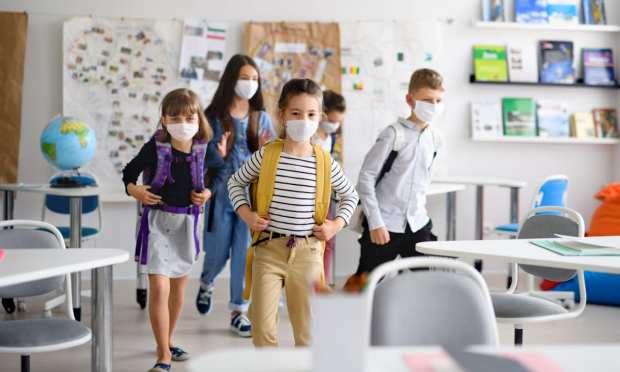Zoom Out: Commerce Adjusts To School Reopenings

For millions of American students, it’s coming up on the first anniversary of their last visit to a classroom. Some students have gone back to in-person learning, some have been in hybrid educational programs that had them half in the classroom and half at home, while another cohort of students has been 100 percent virtual since sometime last March. But it seems that is about to change, as the push to get students back in school has revved up of late, with the backing of newly elected President Joe Biden and state and local officials.
“A lot of work has gone into this to make sure we are ready,” New York Mayor Bill de Blasio said before New York City schoolchildren returned to classrooms on Feb. 25. “Our children are ready. Our parents are ready for kids to be back in school, so we’re very excited about this.”
President Biden has called out getting kids back into a school as a top priority of his first 100 days in office, noting that the shutdown has created mental health troubles for kids, set their education back by a year, widened education disparities for low-income students and disrupted the economy as parents have been forced to exit the workforce to manage their kids’ educations. “We have sacrificed so much in the last year. But science tells us that if we support our children, educators and communities with the resources they need, we can get kids back to school safely in more parts of the country sooner,” Biden wrote, ending his note by stating “we know what we have to do” and that “we need to move fast.”
An increasing number of economists are noting that reopening schools is a move the economy truly needs to return to something like normal. A survey of the Ohio Economic Experts Panel published last week by Scioto Analysis asked whether panelists agreed that “Ohio’s economy will receive a substantial boost as soon as K-12 schools can be safely opened in-person statewide.” Of 32 surveyed, 19 agreed, for a variety of reasons. Some cited long-term harms to the economy caused by a lost year of education.
“Schools remaining closed would reduce the lifetime earnings of the children, thus lowering (gross domestic product) in the long term,” Economist Vinnie Gajjala of Tiffin University argued in the comment section of the survey. “Zoom (is) not (a) perfect substitute for in-person classes.”
Some, however, were more concerned with the more immediate gain of allowing parents to get back to work instead of being stuck at home playing at being educators. “Until schools reopen, there is a limit on how many individuals can go back to work,” said University of Cincinnati economist Michael Jones. “With schools closed, the natural rate of unemployment is higher.”
And parents, according to a Massachusetts study put out this week, are more than ready for their kids to get back to school. “It’s a huge failure of society that schools have been closed so long. We are letting kids down. Enough,” one parent noted in the comments section.
“Absolutely, yes,” wrote another. “There has been no evidence of in-school spread of COVID. Children are struggling significantly and need to be with their peers and teachers for their emotional and mental health and to learn effectively.”
Still, not all Boston area parents, or parents in general, are ready to take the plunge and send their kids back to in-person learning. arguing that it remains too soon for a return to normal that decisive.
“Absolutely NOT,” wrote Kim of Haverhill about sending her six-year-old daughter back to school in April. “My child will remain fully remote. Not only do I think it’s still unsafe, but my daughter is in kindergarten and I believe it would be disruptive to send her in April for 2.5 months. She’s excelling in the remote environment.”
That mix of reactions is consistent with PYMNTS data from late 2020 indicating that consumers are still wildly concerned about resuming their old normal habits in the face of the COVID-19 pandemic. Almost 60 percent of consumers reported that they would need to know that a COVID-19 vaccine was readily available before feeling comfortable returning to their pre-pandemic routines, while 38 percent noted that it is the single most important pre-requisite.
There is a vaccine (actually, in the U.S. there are three vaccines) currently rolling out — but the timetables aren’t yet certain everywhere. That means people are warming up to the idea of kids going back to school, but are not quite sold. As the vaccine is more widely distributed and the pressure continues to mount, a return to school — for better or worse — is likely coming soon to educational institutions everywhere.
